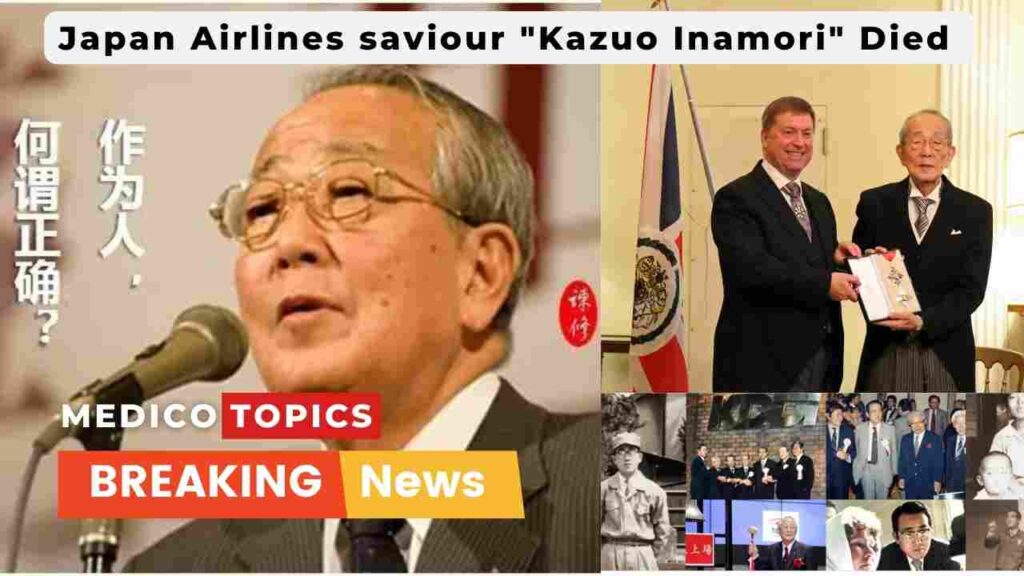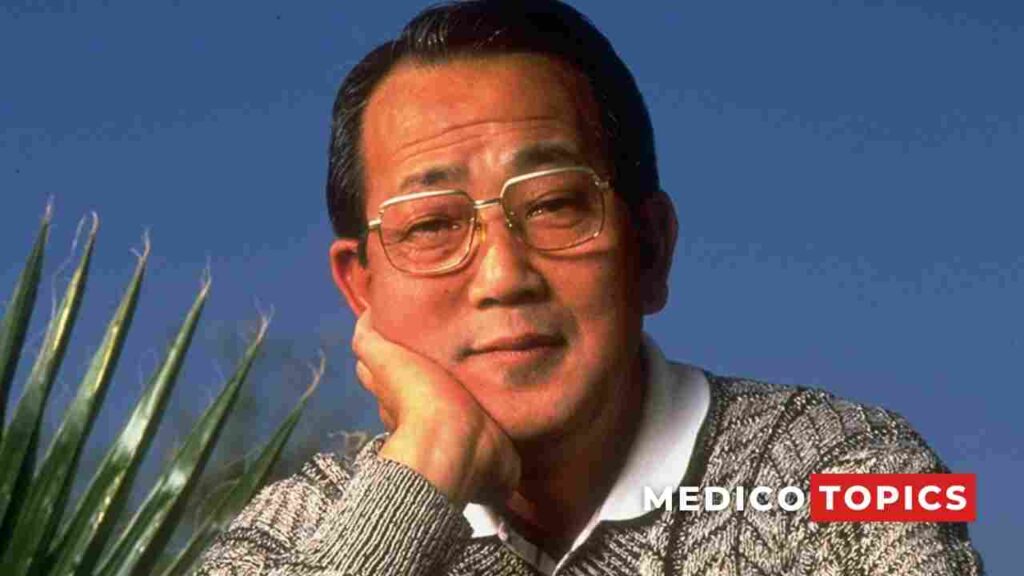
The creator of Kyocera, who also worked to restore Japan Airlines, Kazuo Inamori, died at the age of 90. Let’s see how he died and Kazuo Inamori Cause of death below
How did Kazuo Inamori die?
Kazuo Inamori, the honorary chairman of Kyocera, who founded Kyocera and KDDI and also worked to rebuild the bankrupt Japan Airlines, died of old age on the 24th. He is 90 years old. His funeral/farewell ceremony was held by his close relatives. A farewell party will be held at a later date.
Kazuo Inamori Cause of death
Kazuo Inamori, the founder of Kyocera Corp. and one of the most influential Japanese business leaders, died of natural causes, Kyocera announced on Tuesday. He was 90. In 2010, Inamori became chairman of Japan Airlines Co. in response to an appeal from the Japanese government. He was credited with helping turn the struggling airline’s finances around.
Attempts have been made to contact the family and close friends for comments on the incident by Medico Topics. There have been no answers as of yet. Once we get enough data, we’ll update this page. We’ll soon include more details on Kazuo Inamori cause of death.
Who is Kazuo Inamori?
Kazuo Inamori, who graduated from Kagoshima University’s Faculty of Engineering, was born in Kagoshima, Japan, in 1932.
He started Second Telecom at the age of 52 after founding Kyoto Ceramics Co., Ltd. (now known as Kyocera) at the age of 27. (formerly known as DDI, now known as KDDI, which is currently the second largest communication company in Japan after NTT).
He entered the top 500 in the world throughout his lifetime, and the two big companies have experienced astoundingly strong growth.
Net worth:
Inamori and his family have a net worth of $1.1 billion, putting them 32nd on a list of Japan’s 50 richest people this year, according to Forbes.

Kazuo Inamori’s Philanthropy
The Kyoto Prize is given annually to recognize those who have made “exceptional contributions to science, civilization, and the spirituality of humankind.” Inamori, a Zen Buddhist priest, founded the Inamori Foundation in 1984. The Alfred University School of Engineering in Alfred, New York, was renamed in Dr. Inamori’s honor in 2005.
He established the Inamori Scholarship Fund in 1996, and in 2004 he doubled its size. The Kazuo Inamori School of Engineering’s research faculty will be able to grow thanks to a $10 million endowment gift made in Dr. Inamori’s honor by the Kyocera Corporation. With a $10 million gift in 2005, Inamori contributed to the creation of Case Western Reserve University’s (Cleveland, Ohio) Inamori International Center for Ethics and Excellence. The Inamori Ethics Prize is given by the center to those who serve as moral role models and significantly advance human society.
Kazuo Inamori’s Achievements:
Inamori has received many awards and honors, including:
- Honorary Doctorate from Kagoshima University, 1999
- Honorary Doctor of Science from Alfred University, 1988
- Honorary Doctorate from Kyushu University, 2006
- Honorary Doctorate from Kyoto Institute of Technology, 2010
- International Citizens Award, Japan America Society of Southern California, 2011
- Honorary Doctorate of Science, San Diego State University
- Othmer Gold Medal, 2011
- Honorary Knight Commander of the Order of the British Empire, 2019
Kazuo Inamori as CEO of JAL:
The largest non-financial business bankruptcy case in Japan since the conclusion of World War II was brought by Japan Airlines on the afternoon of January 19, 2010, before the Tokyo District Court. JAL, which has been around for 58 years, was formerly seen as a proud representation of the post-war economic prosperity of “Japan Corporation.”
Haruka Nishomatsu, president of JAL, retired on the same day, and Kazuo Inamori, honorary chairman of Kyoto Ceramics, will lead JAL’s reconstruction. To save JAL, Japanese Prime Minister Hatoyama selected Inamori as Caesar. Hatoyama had earlier stated that if Kazuo Inamori was employed, the Japanese government wouldn’t need to spend tens of billions of dollars in tax monies to reactivate JAL. On January 13, 2010, Inamori Kazuo made it known that he was ready to come out once more. He did, however, make two demands: first, he wanted to work for JAL for free as CEO, and second, he said he wouldn’t move the crew to JAL because nobody in his organization knew anything about flying. Inamori declared: “When it comes to the transportation sector, I am a total “outsider.” Because the government and ETIC intended to do everything possible to stop Japan Airlines from collapsing, I chose to accept the position.” Inamori’s choice to come back was warmly received in Japan. This episode increased Yukio Hatoyama’s satisfaction in the polls and demonstrated the government of Japan’s resolve and decisiveness.
Kazuo Inamori’s contribution to JAL is perceptible
He began serving as the chairman of the newly reconstructed and insolvent JAL on February 1st, 2010. There have been a total of 424 days by the end of March 2011. Three times the profit of “All Nippon Airways,” one year produced an unheard-of profit of 188.4 billion yen for JAL. JAL lost about 180 billion yen, or roughly 360 billion yen, during the same period the year prior. surpasses the Japanese government’s 300 billion yen capital investment to preserve JAL. JAL’s scale has been reduced to two-thirds of its original size due to bankruptcy, and its revenues have decreased to seventy-five percent of the previous year’s level, but the company has still managed to turn a profit that is extremely high by historical standards.
In a horizontal comparison, JAL’s passenger count is lower this year than that of another Japanese airline, “All Nippon Airways,” but its profit is three times higher. This is due to downsizing. This miracle is truly amazing. In just one year, JAL has reached three firsts, one in the world in profit, one in the world in punctuality, and one in the world in service level. Even if Inamori leaves JAL, JAL can continue to grow healthily. Kazuo Inamori’s philosophical ideas can always push forward the thinking of JAL cadres, thereby promoting the development of JAL.
Kazuo Inamori Save Japan Airlines
When he was focusing on his studies of Buddhism and relishing his later years in 2009, Japan Airlines filed for bankruptcy with a debt of 1.5235 trillion yen (about 122 billion yuan). The “wing” of Japan, Japan Airlines is also the third-largest airline in the world. Then Prime Minister Yukio Hatoyama invited Kazuo Inamori to be the chairman of the bankrupt corporation, saying, “This company must be salvaged.” Save”. Unexpectedly, Kazuo Inamori quickly concurred.
The Japanese government’s corporate regeneration support organization provided 350 billion yen in financial support to Japan Airlines when he was in charge. The transaction banks also ultimately consented to forego their 521.5 billion yen claims at the same time. Japan Airlines transformed losses into profits in the second year after declaring bankruptcy and reconstruction after putting several “reconstruction strategies” into action. The business not only kept up its black business in 2011 but also generated a net profit of 186.6 billion yen. Japan Airlines relisted on the Tokyo Stock Exchange in September 2012 and said, “I’m back!”
Inamori’s contribution to China:
In 1975, Inamori paid for his first trip to China. After that, he visited China on multiple occasions and developed a close bond with it. A group of Chinese government representatives led by Mr. Zhang Jinfu, who was the country’s State Councilor at the time, visited Kyocera Corporation at the start of 1985 to foster relations between China and Japan. Inamori announced during the conference that Kyocera was working hard to develop a new form of energy for the future – solar cells – and stated his goal to immediately present China with a set of “Kyocera-produced solar power generation equipment.”
This idea piqued the interest of Head Zhang Jinfu, and soon after, the initiative was launched in China and Japan. Kyocera additionally contributed money to the “Japan-China Yangtze River Civilization and Academic Joint Study Group.” Additionally, he participated in several exchange programs in China, including the “Chinese Youth Friendly Exchange Visiting Group” and the “Inamori Kyocera Western Development Scholarship Fund,” which he founded in 2001. Give scholarships to students from 12 representative universities in western China who are good in character, are enrolled in school, and need financial assistance.
Inamori thinks that China must cultivate several exceptional talents immediately if it is to pursue sustainable development in the future. Based on this concept, the creation of the “Inamori Kyocera Western Development Scholarship Fund” and the “Chinese Youth Friendly Exchange Visiting Group” initiative both aim to make a tiny contribution to China’s talent development.
Tributes to Kazuo Inamori:
A loving, affectionate, sincere and harmonious heart is the foundation that leads a person to success. Kazuo Inamori Founder and Chairman Emeritus of Kyocera Corporation Learn more here: global.kyocera.com/inamori/philos
We must adopt a humble attitude that welcomes criticism as constructive advice provided to help us improve. – Kazuo Inamori, Founder and Chairman Emeritus of Kyocera
KEEP READING,
Who was Kaylee Gansberg? How did the student die in MI hit and run crash?
How did Vincent Cheng die? Former HSBC banker Cause of death
Follow us on Twitter to get the latest news.
Lavanya (Senior Editor) is a full-time content writer with almost 5 years of experience and a part-time teacher. She joined Medico Topics on the Breaking News trainee scheme in 2022 and now works on MedicoTopics.com. As a lifelong learner, She is constantly curious about learning new things and passionate about sharing knowledge with people through her writing and teaching.
